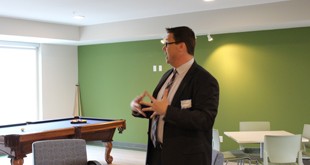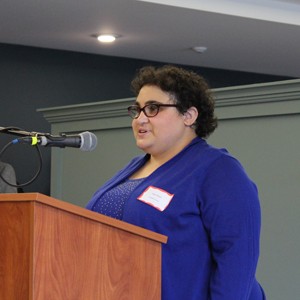Cornerstone Creek is an affordable housing building that’s the home to Jewish Housing and Programming (J-HAP), the 10-year-old agency that is part of the team that opened the 45-unit apartment building in January for adults with developmental disabilities.
“[J-HAP] has been about changing the face of what the community of developmental disability looks like,” said Jeff Sherman, the executive director “It really is about people who need assistance doing the same thing everybody else does. It’s just folks that need additional supports.”
J-HAP was founded by Linda Bialick who began advocating for her daughter, now 30, who has a developmental disability.
“When I wanted to supplement her early intervention preschool with a typical preschool, I made some phone calls and was told there was nothing in our community like that,” she said. “I started advocating for children with developmental disabilities. What we found was that when kids were done with school the programming stopped. So we had to start all over again.”
Bialick said that this generation of children with developmental disabilities, thanks to healthy lifestyles and improved medical technology, would be the first to outlive their parents.
“We were looking for housing where they could maintain their Jewish identity and have an abundance of recreational and social and educational opportunities,” she said. “That was 10 years ago. And this is a result.”
The building opened in late January and there are more than 31 signed leases. Some of the residents are slowly transitioning to living on their own; some are coming from a group home or living with their parents, while others already live on their own. There are 40 one-bedroom units and five two-bedroom units. There are also three ADA-compliant apartments and three that can be converted to ADA accessibility; only one was required by statute. The apartments all have washers and dryers, as well as full kitchens.
The building has a spacious seating area in the lobby for residents to wait for Metro Mobility for transportation. A kosher kitchen will be installed and will serve dinner five nights a week. Each floor also has a small kitchenette with a long table and seating for 10, that can be used for shared meals or skill building activities.
“It was intentionally designed this way to combat the isolation that many folks feel,” Bialick said. “If you’re living in a scattered-site apartment, there isn’t a lot of socialization. We like to think of it as a college dorm and J-HAP is the [resident assistant].”
Said Sherman: “When you look at an affordable housing project, they don’t provide the high ceilings or lots of windows, and they don’t compare with a market rate apartment or somewhere you’d want to live. This building was designed with that in mind.”

Scott Beckman from Urban Works Architecture, Cornerstone Creek’s design firm, discusses building features on a tour of the facility.
The rents range between $465 and $700 per month for a one-bedroom apartment and $835 for a two bedroom. The range is based on funding and when people signed leases. The construction of Cornerstone Creek is thanks to a complicated confluence of funding and public agencies.
Bialick said they raised $10.3 million in government money, which is what leads to regulations about the number of units and a certain rent level. Everybody lives at 60 percent or below of the area median income level. J-HAP has raised $1.8 million of an ongoing $3 million capital campaign that pays for the public spaces.
“Anything you wouldn’t see in a typical low-income housing project,” Bialick said. “The lounges and fitness center are the things J-HAP pays for and makes it unlike anything in Minnesota.”
What makes Cornerstone Creek different?
Bialick and Sherman explained that most of the of the residents come with two pots of money: Supplemental Security Income which covers rent and food, and a county waiver that pays for support and care.
“In traditional housing for people with developmental disabilities, a service provider would capture all that money and control their services,” Sherman said. “Here, our tenants retain all their money, are in total control of their finances, and they schedule their help when they need it.”
An April 27 event to show off the building to the business community that helped make it possible featured Minnesota Housing Finance Agency, Hennepin County, the city of Golden Valley, Bremer Bank, U.S. Bancorp Community Development Corporation, and the Federal Home Loan Bank.

Resident Lisa Liszt: “It’s such a wonderful feeling to live in this beautiful new building.
I feel fortunate to live in safe, affordable housing that I feel comfortable coming home to in a good neighborhood. “
“I worked on this for three years and I was a relative newcomer to it,” said Heidi Rathmann, the senior vice president of the Community Housing Development Corporation, which works to develop affordable housing around the Twin Cities. “It’s one of the most complex partnerships we’ve put together.”
The building was built primarily on tax-credit funding through Minnesota Housing Finance Association. “What happens in a project, you receive the award from MHFA and you look for a tax-credit investor. In this instance it’s US Bank,” said Bialick. “US Bank owns 99.9% of the building for 15 years. In 15 years, J-HAP will have the first right to buy the building, but typically in a project like this, you look for more tax credits so you can make improvements on the building.”
The other percentage is owned by CHDC. J-HAP is the co-developer and provides support-enriched services. What J-HAP has done is set itself to be a national model.
“People think about it as a nursing home or assisted living facility and I think that’s the stigma that just because someone has a disability, it doesn’t mean they have to live in an assisted living facility,” Sherman said. “And we’re seeing that proven person by person: You bring in enough support to get you what you need, but it’s not one size fits all.
“Yes, this model works. People are happy. They are getting up every day and doing what they normally do.”



3 comments